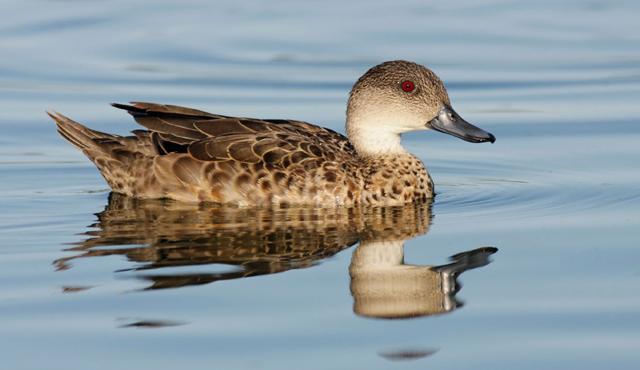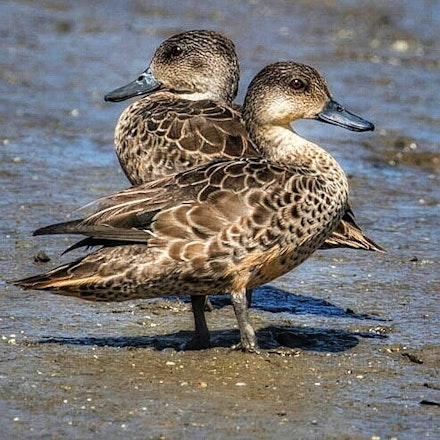Grey Teal


Scientific name
Anas gracilis
Alternative names
Also known as Grey Teal Duck or Tētē in Māori (New Zealand).
Measurements
| Feature | Range |
|---|---|
| Length | 40–48 cm |
| Weight | 500–600 g |
| Wingspan | 75–85 cm |
| Egg size | 49 × 36 mm |
Status
Listed as Least Concern on the IUCN Red List. Fully protected in New Zealand but considered a game species in Australia, where hunting is allowed in certain regions.
Identification
A small, mottled brown duck with a light face and a reddish-brown eye, brighter in adult males. Both sexes look alike, unlike the Chestnut Teal. The bill is blue-grey with darker edges, and the legs and feet are grey. The wings show white and green patches, and the head has a dark crown with a pale throat and cheeks. Juveniles are paler and have dull brown eyes until maturity. In flight, the grey and white contrast on the wings is visible.
Voice
A vocal species, especially at night. Females give a loud, harsh quack, while males make softer whistles and short “preep” notes. Their calls sound almost identical to those of the Chestnut Teal.
Diet
Feeds mainly on small aquatic insects, larvae, crustaceans, molluscs, and seeds from wetland plants. It forages by dabbling and up-ending in shallow water or by filtering food from mud along lake and estuary edges. During breeding, pairs or families feed together, but outside the season, they join large flocks.
Behavior
Grey Teals are social, often forming large groups outside the breeding season. They are highly nomadic, moving quickly to new wetlands after rain or flooding. They pair for life, and both parents guard the nest and brood. Adults go through a complete moult after breeding, becoming flightless for a short period.
Distribution
Found throughout Australia, New Zealand, New Guinea, and parts of Indonesia, with occasional sightings in New Caledonia and the Solomon Islands. It is one of the most widespread ducks in Australasia and adapts easily to changing water conditions.
Habitat
Prefers shallow freshwater lakes, lagoons, swamps, and marshes with plenty of vegetation. It also uses coastal estuaries, salt lakes, and brackish wetlands. Nests are built on the ground among reeds or in tree hollows near water. It avoids high elevations, usually staying below 900 m.
Breeding
Breeding time depends on rainfall and water availability. In New Zealand, nesting mostly happens from September to November, while in Australia it can occur year-round. Nests are simple bowls lined with grass and down, placed in vegetation or tree hollows. Females lay 6–14 creamy white eggs and incubate them for about 25–31 days. Ducklings leave the nest soon after hatching and can swim immediately. Both parents protect the brood, though females do most of the care.
Wintering
Grey Teals do not have a fixed migration season but move freely across regions in search of water and food. Many stay in the same wetland year-round if conditions remain suitable, while others travel hundreds of kilometers after droughts or storms.
Conservation
Populations are large and stable, but local declines occur due to hunting and wetland loss. Foxes, harriers, and stoats prey on eggs and ducklings, while diseases like Sarcocystis can affect muscle strength. In Australia, they are heavily hunted, and many are injured or killed each season, while in New Zealand, they remain protected and continue to increase in number.
